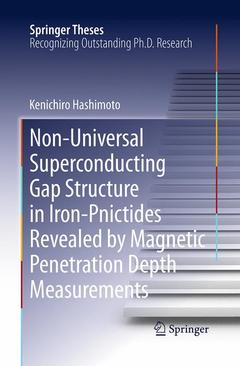Non-Universal Superconducting Gap Structure in Iron-Pnictides Revealed by Magnetic Penetration Depth Measurements, 2013 Springer Theses Series
Auteur : Hashimoto Kenichiro

In this book the author presents two important findings revealed by high-precision magnetic penetration depth measurements in iron-based superconductors which exhibit high-transition temperature superconductivity up to 55 K: one is the fact that the superconducting gap structure in iron-based superconductors depends on a detailed electronic structure of individual materials, and the other is the first strong evidence for the presence of a quantum critical point (QCP) beneath the superconducting dome of iron-based superconductors.
The magnetic penetration depth is a powerful probe to elucidate the superconducting gap structure which is intimately related to the pairing mechanism of superconductivity. The author discusses the possible gap structure of individual iron-based superconductors by comparing the gap structure obtained from the penetration depth measurements with theoretical predictions, indicating that the non-universal superconducting gap structure in iron-pnictides can be interpreted in the framework of A1g symmetry. This result imposes a strong constraint on the pairing mechanism of iron-based superconductors.
The author also shows clear evidence for the quantum criticality inside the superconducting dome from the absolute zero-temperature penetration depth measurements as a function of chemical composition. A sharp peak of the penetration depth at a certain composition demonstrates pronounced quantum fluctuations associated with the QCP, which separates two distinct superconducting phases. This gives the first convincing signature of a second-order quantum phase transition deep inside the superconducting dome, which may address a key question on the general phase diagram of unconventional superconductivity in the vicinity of a QCP.
Introduction.- Superconducting Gap Structure and Magnetic Penetration Depth.- Iron-based Superconductors.- Experimental Method.- Superconducting Gap Structure and Quantum Critical Point in BaFe2(As1-xPx)2.- Superconducting Gap Nodes in the Zone-centered Hole Bands of KFe2As2.- Nodeless vs. Nodal Order Parameter in LiFeAs and LiFeP.- Conclusions.
Dr. Kenichiro Hashimoto
Department of Physics, Kyoto University,
Kyoto, Japan
Presents studies on the superconducting gap structure in the recently discovered iron-based superconductors
Provides a detailed description of experimental principles and methods for the magnetic penetration measurements including the tunnel diode oscillator and microwave cavity perturbation techniques
Investigates the non-universal superconducting gap structure with and without nodes in iron-pnictides
Nominated as an outstanding Ph.D thesis by Kyoto University’s Physics Department in 2011
Includes supplementary material: sn.pub/extras
Date de parution : 08-2016
Ouvrage de 125 p.
15.5x23.5 cm
Disponible chez l'éditeur (délai d'approvisionnement : 15 jours).
Prix indicatif 105,49 €
Ajouter au panierDate de parution : 02-2013
Ouvrage de 125 p.
15.5x23.5 cm
Disponible chez l'éditeur (délai d'approvisionnement : 15 jours).
Prix indicatif 105,49 €
Ajouter au panier


